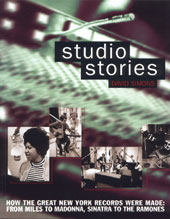Studio Stories
By David Simons
Backbeat Books 2004, $24.95, pp192
The
first weeks of 2005 showed the ever-changing world of Pro Audio being
subjected to even faster changes than of late, in a way these changes
appearing to indicate a point of no return for music. The first really
big news, just a few hours into 2005, concerned the closing of the last
manufacturer of professional reel-to-reel analogue audio tape left in
the whole world: the Opelika plant, owned by Quantegy. And though at
the end of last month it was announced that a buy-out had been arranged,
still the episode shows the current precarious conditions of a recording
technology that some still consider as an integral part of their recording
aesthetic.
Things
didn't stop there. First, there were news about the L.A.-located Cello
studios - which used to be Oceanway, which used to be Western Recorders
- closing their doors at the end of January. Then, the closing of the
equally famous - and apparently still going strong - The Hit Factory
in New York. Readers can easily picture the heated debates taking place
on those Forums where issues of technical nature are discussed.
But isn't a pity that this kind of topics are left as the exclusive
province of "tech people"? Sure, on the surface - thanks in
no small part to the personality-driven format of the music press -
these things appear as being of no importance to the average listener.
But it was just a few years ago that I read an interview with (Giant
Sand's) Howie Gelb where in the course of the conversation he stressed
the importance of "room sound" quite a few times. And wasn't
the factor called "acoustic labelling" such an important part
of the sound that one could hear on albums recorded in those big, and
glorious, studios that for the most part are now history?
Studio
Stories by David Simons (subtitle: How The Great New York Records Were
Made: From Miles To Madonna, Sinatra To The Ramones) deals with a slice
of that history. Of course, the author is well aware of the changing
times - on the cover it is said that the book "(...) is, in many
ways, a portrait of a lost world, swept away by technological change
- but a world from which we can still learn so much". Of course,
much of it is ultimately subjective - just as this writer cannot seem
to stand any 20- and 24-bit remastering of practically any old album,
so a 18-year old he's not likely to tolerate any tape hiss. Still, the
book is a nice read, though it occupies a somewhat strange position:
not a (almost general) history of record production like Mark Cunningham's
Good Vibrations (published by Sanctuary in 1996, reprinted in 1999),
nor a deep tech talk like Howard Massey's Behind The Glass - Top Record
Producers Tell How They Craft The Hits (Miller Freeman Books, 2000. Backbeat Books, 2002). But Simons has written a very good book,
rich with interviews and pictures. I'd call it required reading for
those who know what the word Pultec means and for those who have never
heard that word before but who really listen to the records they own.
In
their various incarnations, Columbia Studios play a very important part
in this New York story (a map of central New York City, 1962 showing
where studios were located opens the book). Just like engineer Frank
Laico, whose work is widely discussed (he's also interviewed at length).
We also can read about the "rock transformation" taking place
at Columbia (think: Dylan's Like A Rolling Stone), and we have a nice
interview with Roy Halee, with a discussion about the recording of specific
tracks by Simon & Garfunkel.
We
also encounter Atlantic Studios and Tom Dowd. Echo chambers. A&R
Studios and Phil Ramone (and The Making Of Getz/Gilberto). Goffin &
King. The Shangri-Las. The Lovin' Spoonful (great). Aretha Franklin
(and an interview with Jerry Wexler and Arif Mardin that's not terribly
revealing but it's a nice read nonetheless). An interview with session
guitar player Al Gorgoni (maybe you haven't heard of him, but you've
heard him). Stevie Wonder in his Malcom Cecil/Robert Margouleff period
(there's a nice interview with Margouleff). There's also Ed Stasium
discussing his work with The Ramones, particularly Rocket To Russia
(and here there could be a few surprises for most fans of the group).
The
bulk of the book ends here, at the dawn of the digital age, with a look
at Madonna. There are nice additions. A look at some specific tracks
(by Elvis Presley, Left Banke, Tommy James, Dick Haley, Ella Fitzgerald
& The Duke Ellington Orchestra, Led Zeppelin, Dionne Warwick, Janis
Ian, Talking Heads, Alice Cooper, Stevie Wonder) and at the places where
they were recorded. Also something about "out-of-towners"
studios, such as the world-famous Sigma Sound Studio (in Philadelphia)
and the celebrated Van Gelder Recording Studio (Englewood Cliffs, NJ).
Beppe
Colli
©
Beppe Colli 2005
CloudsandClocks.net
| April 5, 2005











